My Matcha Basque Burnt Cheesecake is creamy and custardy with a subtle caramel flavor and an earthy sweetness. Its iconic deep-brown top contrasts beautifully with a vibrant green interior from green tea powder. As a Japanese-style cheesecake, it’s even lighter and fluffier than the classic version and surprisingly easy to make. This delicious, heavenly dessert is the cheesecake of your dreams!
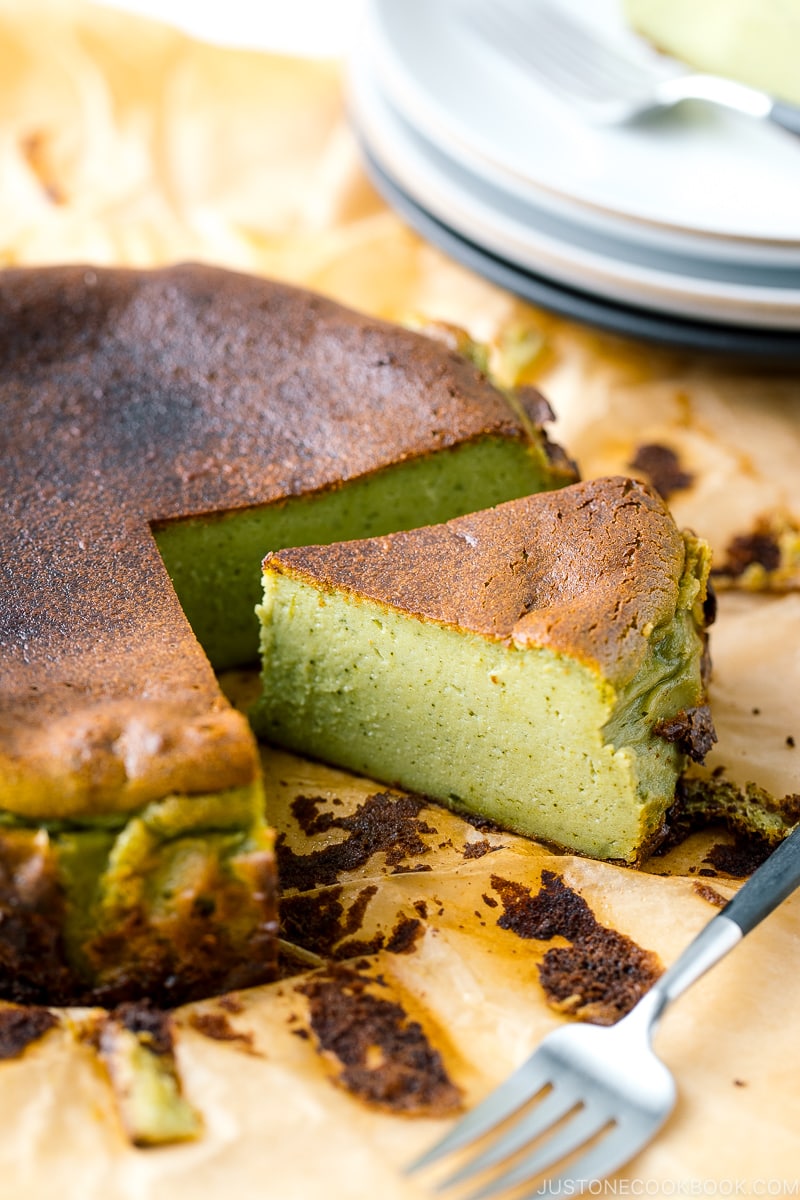
As promised in my Basque Burnt Cheesecake recipe, I’m here to share the Japanese-style Basque Cheesecake with matcha flavor! This Matcha Basque Burnt Cheesecake (抹茶バスクチーズケーキ) is actually our family’s favorite. For good reasons. 🙂 You can find out why later, but I can assure you that both of these cheesecakes are equally outstanding and heavenly. So I hope you try both versions!
Table of Contents
First of All, What is Basque Cheesecake?
For those who are not familiar, Basque Cheesecake has the iconic “burnt” exterior and it is very creamy on the inside. It tastes like a caramelized cheesecake in one bite. Some liken it to creme brûlée cheesecake!
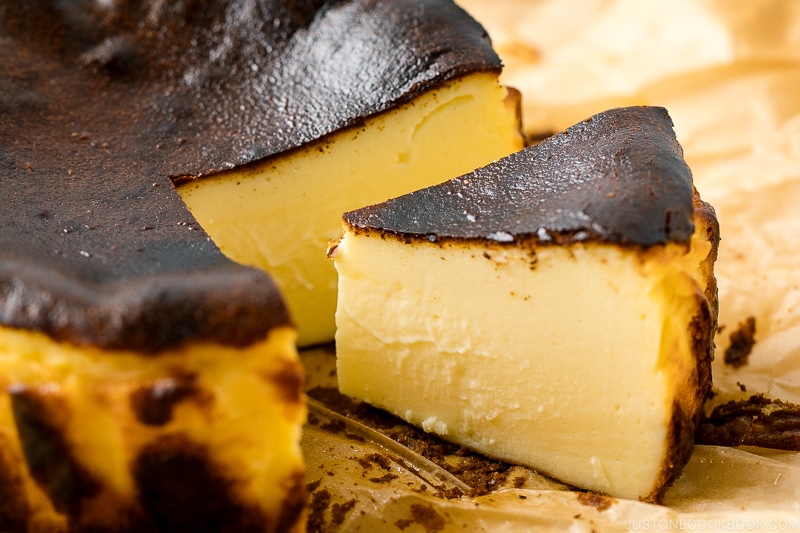
Basque Cheesecake is relatively new. It was created in 1990 by a chef named Santiago Rivera of a restaurant called La Viña in San Sebastian, Spain. If you’re interested, read this article or this article that explains how this cake was invented and became popular.
If you like to make my classic Basque Burnt Cheesecake, click here.
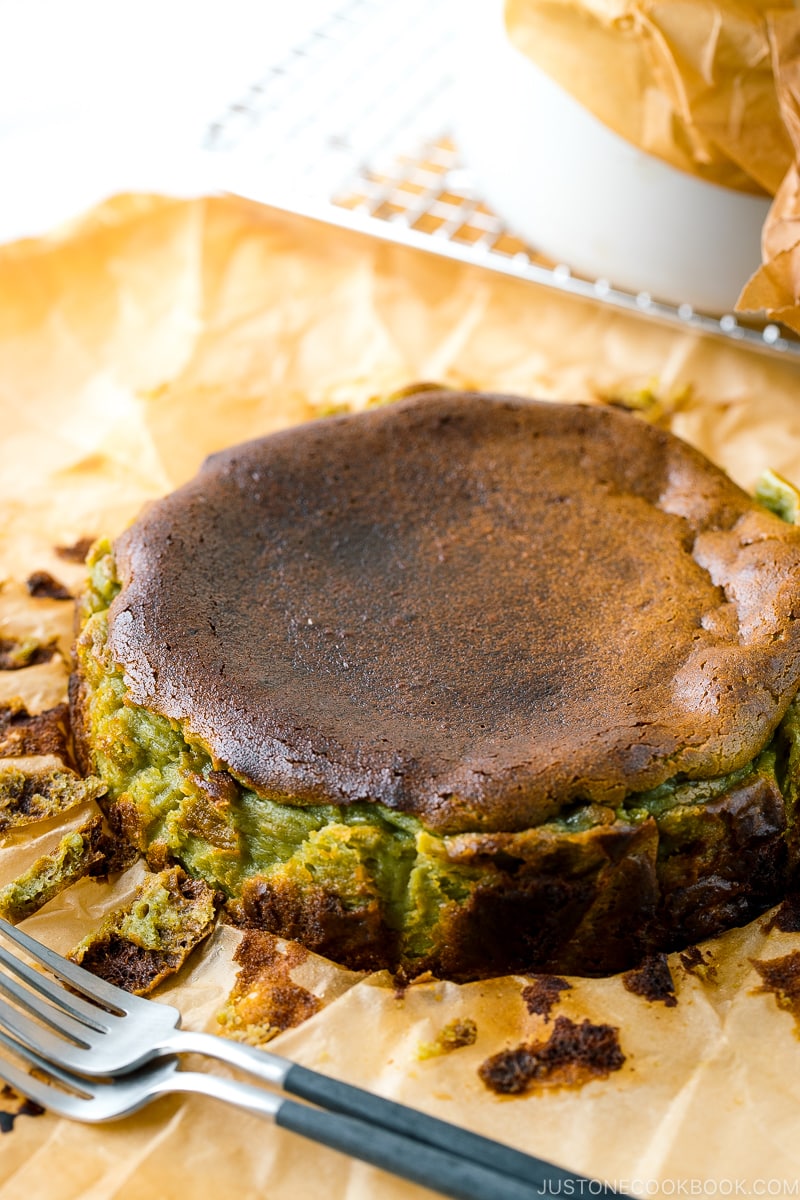
Japanese-Style Basque Cheesecake
So, what makes this Basque Cheesecake uniquely Japanese? Besides the matcha flavor, it contains less cream cheese per cheesecake, compared to the typical Basque Cheesecake (in precise, half the amount).
The Matcha Basque Cheesecake I made today is based on this recipe posted on this Japanese home cook/baker Instagrammer. She mentioned in her post that her recipe was adapted from Rumi Kojima’s Basque Cheesecake recipe (She’s a very renowned patissier in Tokyo). After researching Basque Cheesecake recipes a bit more online, I can conclude that the majority of Japanese-written Basque Cheesecake recipes have half the amount of cream cheese.
As a result, ‘Japanese-style’ Basque Cheesecake has a lighter, fluffier texture. With the higher egg ratio, the inside is even more custardy and creamy. You can say it’s similar to flan, and the matcha imparts a hint of sweet earthy vanilla note to it.
If you want to make Japanese-style Basque Cheesecake without matcha flavor, you can simply replace matcha with lemon juice in this recipe.
Just like regular Basque Burnt Cheesecake, this is absolutely the easiest cheesecake I’ve ever made. All you need to do is to mix ingredients, bake for 30 minutes, and chill.
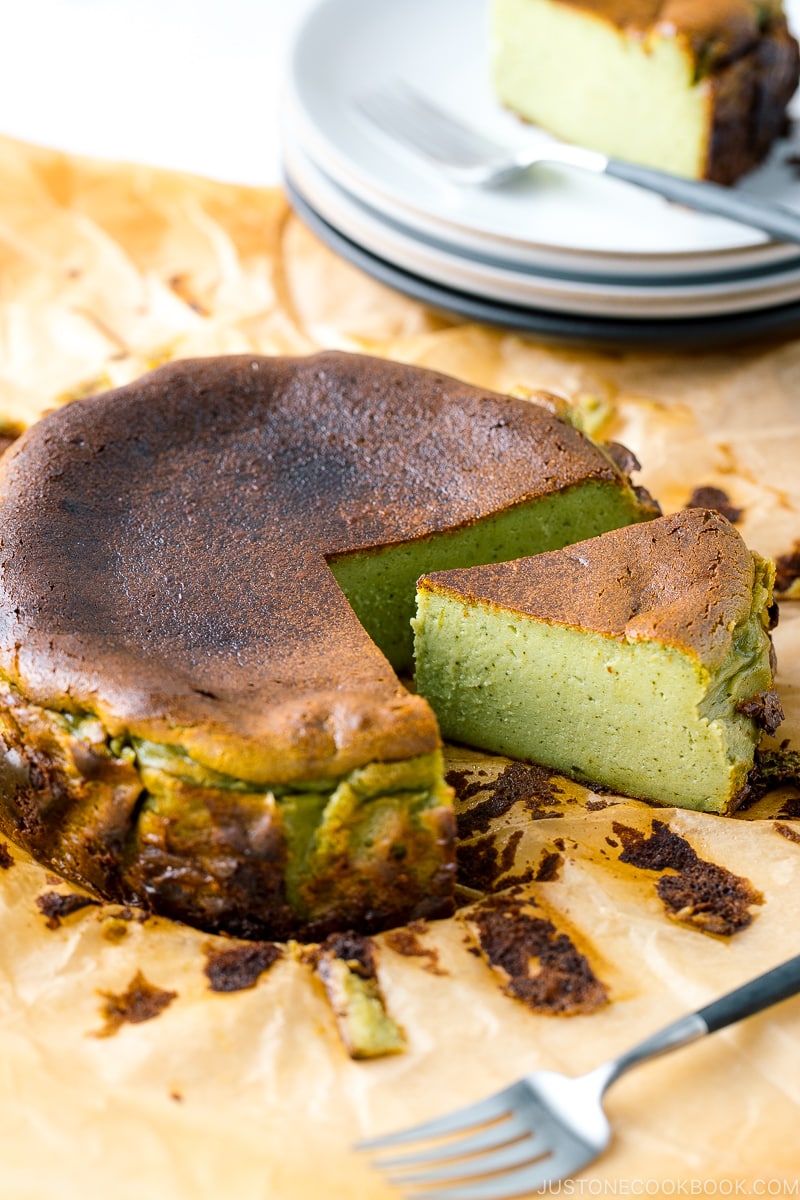
How to Make Matcha Basque Cheesecake
Ingredients You’ll Need
- Cream cheese (Philadelphia, NOT whipped cream cheese or reduced-fat)
- Sugar (Standard granulated sugar, I used organic cane sugar)
- Eggs (Large eggs, 50 g each without shell)
- Heavy (whipping) cream (36-38% fat)
- Flour (I used cake flour + corn starch)
- Matcha (high quality, vivid green matcha powder)
- Salt (to intensify the flavors)
Overview: Cooking Steps
The full printable/written recipe with step-by-step pictures is below.
- Preheat the oven for at least 30 minutes. Also bring the cream cheese, eggs, and heavy cream to room temp.
- Gradually mix all the ingredients, one at a time, in a large bowl.
- Pour the batter into a cake pan and bake for 30 minutes.
- Let cool completely at room temperature (about 2-3 hours).
- Chill in the fridge, and enjoy!
This is an excellent recipe for any beginner to try.
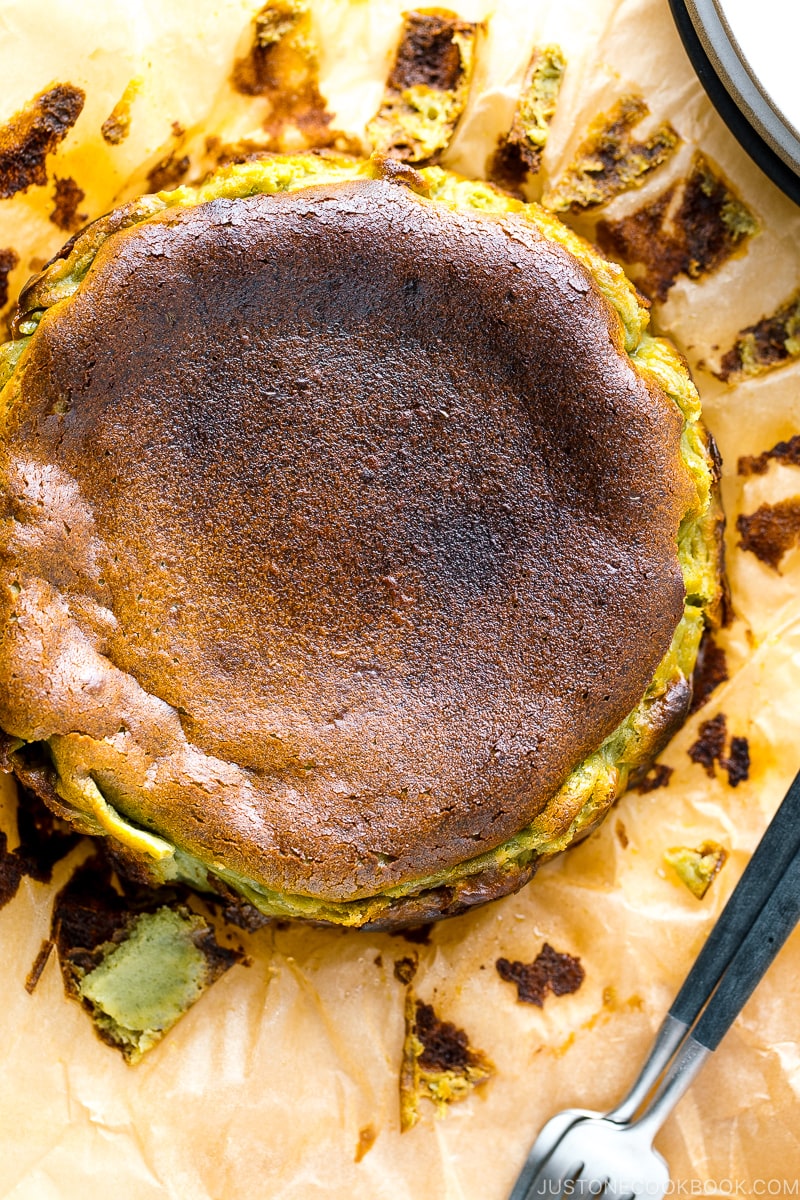
A Recommended Tool: 6-Inch (15-cm) Round Cake Pan
As the majority of Japanese-style Basque Cheesecake recipes require a 15-cm pan, and I happened to have one at home that’s a 3-inch deep 6-inch round cake pan with removable bottom, I used it and it’s really a perfect cake size for 6 people (or 4 if you want to eat a bigger size).
You can definitely go with a 2-inch, maybe 2.5-inch deep 6″ cake pan (by folding the parchment paper up to sustain the rising batter), but if you plan to use a larger round pan, this recipe will create a short and shallow cheesecake. It will not produce the same rich and luscious texture.
You can multiply the recipe by 2 to accommodate for a 3-inch deep 7-inch round pan, or multiply the recipe by 2.5 to accommodate for a 3-inch deep 8-inch round pan.
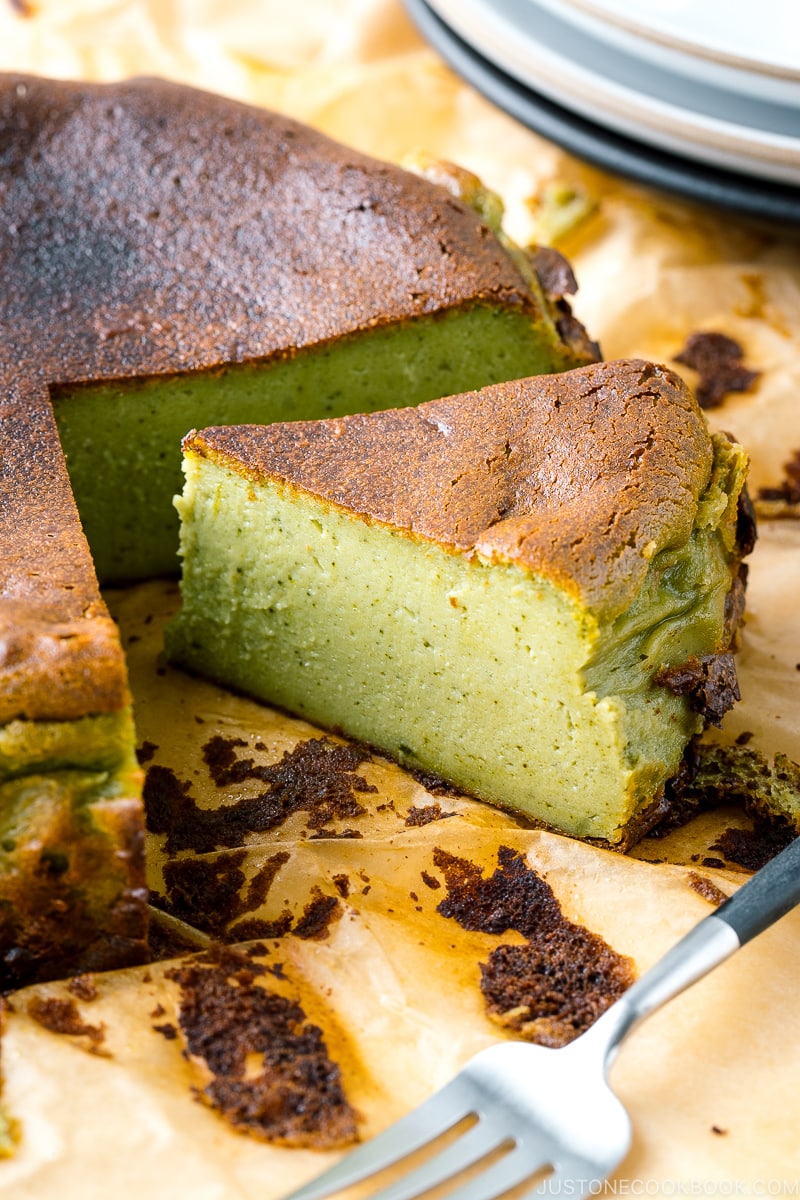
10 Important Tips to Remember
Tip #1: Preheat the oven for at least 30 minutes.
To achieve a nice brown top in a short time, the oven has to be very HOT. Here’s something you can do besides preheating for 30 minutes:
- Use the convection bake (oven with fan). This worked like a miracle. I had tested using a regular conventional oven (no fan), but I couldn’t achieve the ‘burnished’ top. Once I switched over to the oven with fan, bam, the perfect burnt top right away! Circulating air with a fan definitely helps to distribute hot air evenly inside the oven.
- Preheat the conventional oven at a higher temperature. I preheated the oven to 550ºF (290ºC) for 30-45 minutes! If you don’t have a fan to circulate the air, you can position the rack at a higher location as the heat rises and the top of the oven will be hotter. Be careful the parchment paper is not touching your heating element.
Tip #2: Use parchment paper.
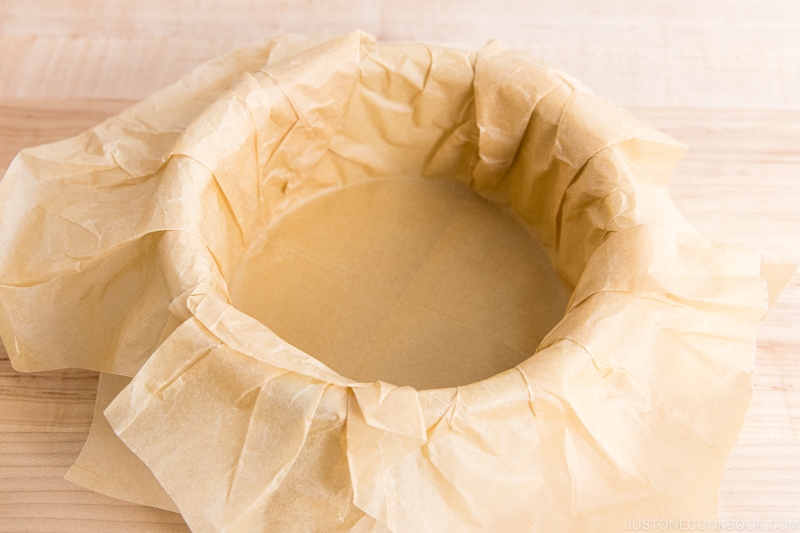
Don’t skip or substitute it. And double line it to ensure there aren’t any unlined parts. If your cake pan is not 3-inch deep, you may need to fold the parchment paper up to support the rising cake batter (but make sure the paper is not touching the heating element in the oven)
Tip #3: Make sure cream cheese, eggs, and heavy cream are at room temperature.
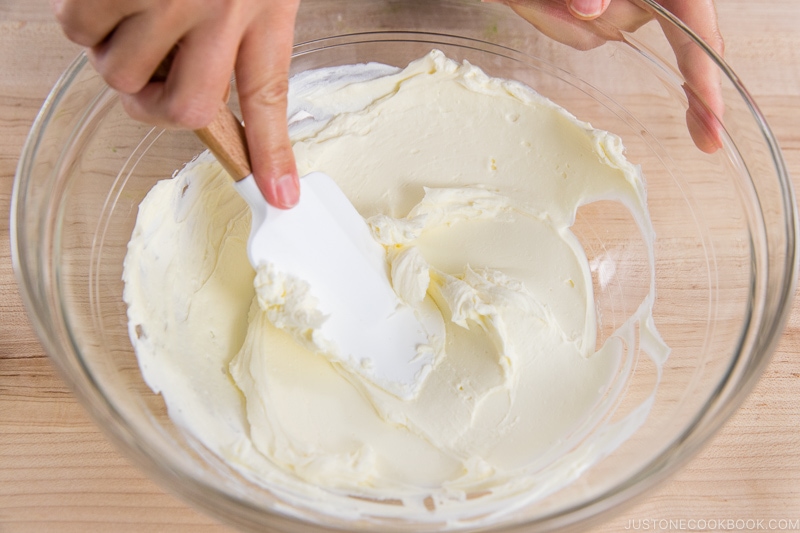
Room temperature ingredients blend together very easily, creating a smooth batter. A smooth batter will yield a uniform textured baked good. Cold ingredients do not incorporate together as easily. You can microwave the cream cheese to warm up, and I share the instructions in the recipe.
Tip #4: Avoid lumps!
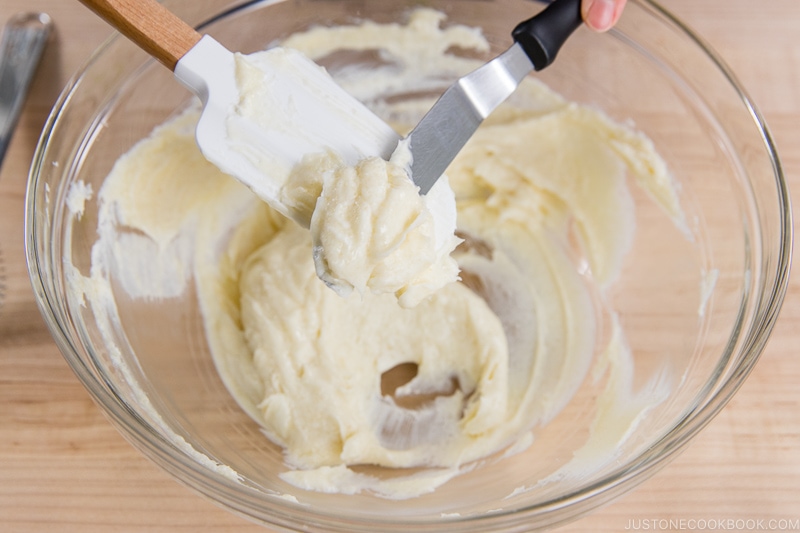
Lumps are so hard to get rid of. It’s easier to prevent creating lumps than get rid of them. There are two ways to avoid them:
- Mix the batter completely and thoroughly before adding the next ingredient.
- Frequently scrape off the chunks of batter from the spatula and bowl. Further steps go, the batter gets more liquid, which means it’s harder to get rid of lumps. So if you see any lumps, get rid of them as soon as possible.
You can press the spatula down in a rubbing motion to remove cream cheese lumps. You may still end up with small bits of lumps. Don’t worry too much as it will dissolve while baking. But in general, you don’t want to create lumps.
Tip #5: Mix matcha with a small amount of batter first.
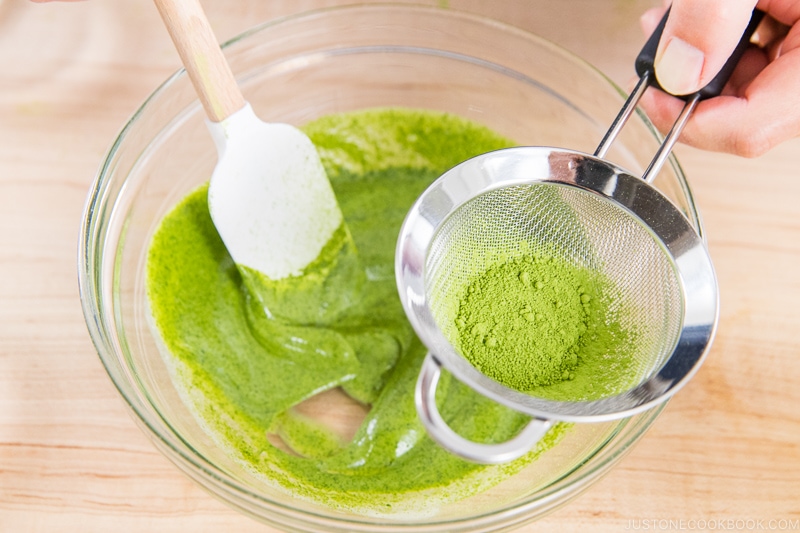
No one wants spotty green cheesecake. Matcha tends to clump together when the dry fine powder hit the liquid. Whenever you want to add matcha to the liquid or batter, remember to take out some portion and create the “matcha paste” first. It’s easier to blend the paste into the liquid/batter.
Tip #6: Release the air bubbles before baking.
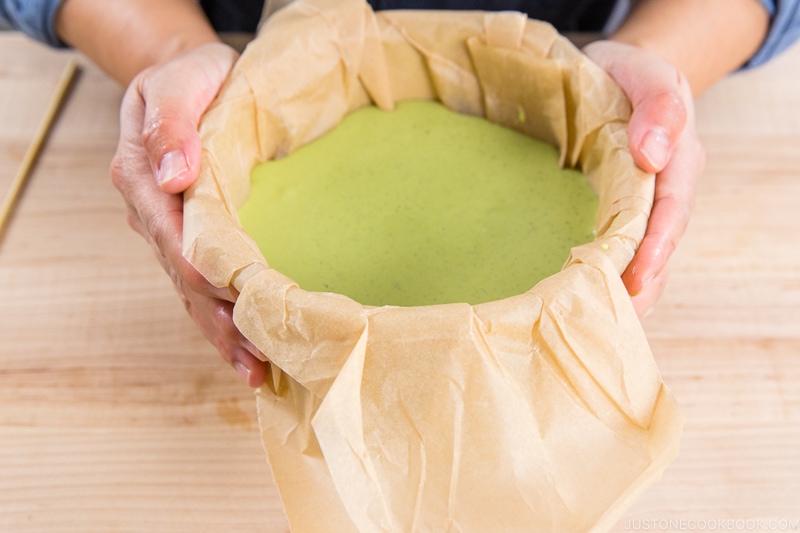
After making these cheesecakes with different tools for fun (stand mixer, electric hand mixer, blender, whisk, and spatula), I learned that mixing the batter with a silicone spatula creates fewer air bubbles and make pretty consistent cheesecake. If you prefer to use a mixer and your batter has a lot of air bubbles, make sure to tap the cake pan on the countertop to release the air pockets in the batter. You can also use a skewer to run the batter and pop the air bubbles too. This will help create a smooth, glistering surface on the cake as opposed to a bubbly top or major collapse after rising too high.
Tip #7: Open/Close the oven fast and don’t lose the hot air!
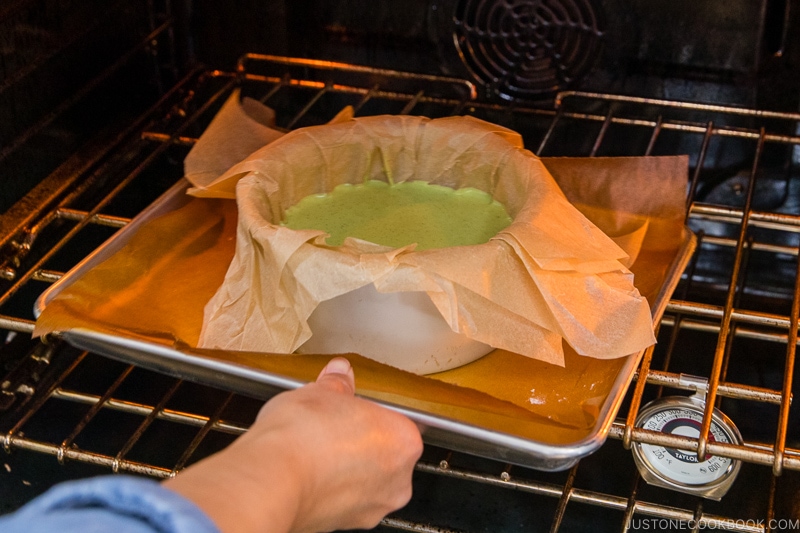
I know this may sound like common sense to you, but I was once a beginner baker who took time to put the cake pan in the oven, leaving the oven door for a long time. Since you work extra hard to preheat the oven for 30-45 minutes, don’t waste the hot heat in the oven!
Tip #8: Use my bake time as a guide only.
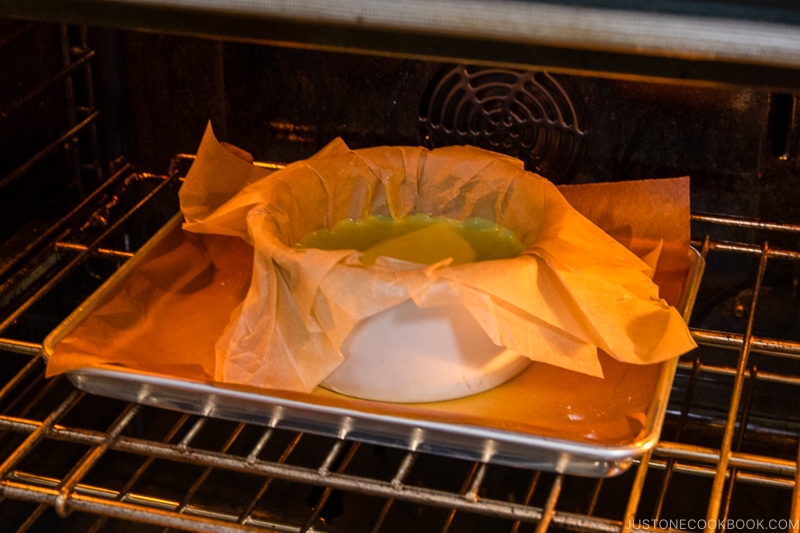
Every oven is different based when it comes to the size and how it works. My relatively new oven is not perfect. It has hot spots, and the internal temperature doesn’t seem to be the same as what the display says. It can be a headache, but you and your oven get to know each other through baking.
So you have to determine when to take the cheesecake out of the oven by looking at 2 things: the color of the cheesecake surface and baking time. DO NOT keep baking just because the top doesn’t get burnt enough. You do not want to eat overcooked cheesecake. The cake is done while it is still wobbly in the middle. So take it out even though the top doesn’t turn deep brown.
Tip #9: Control the doneness of the cheesecake to your liking.
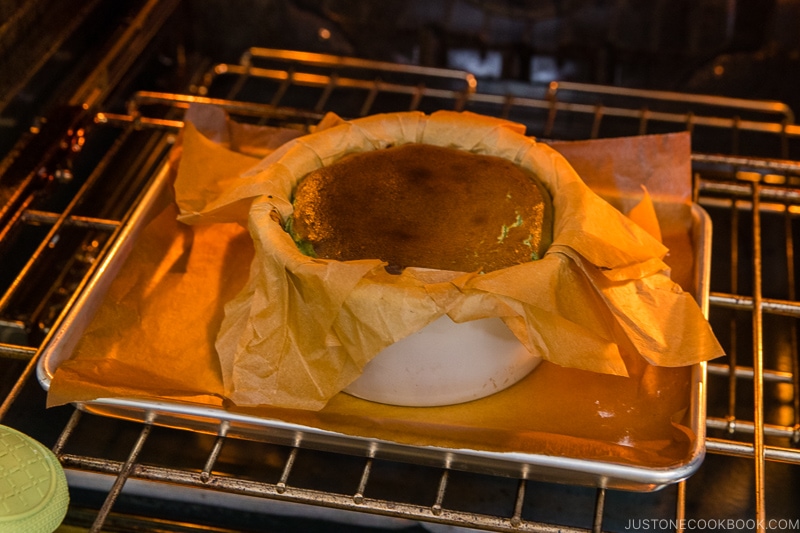
You may not be able to achieve the perfect texture on your first try as you need to learn what you like (texture-wise) and how your oven works. However, as you figure out the details, it’s totally possible to customize the doneness of the cheesecake.
To achieve a creamy texture:
- Bake at a normal time in the oven.
- The cheesecake filling will firm up as it cools to create a creamy yet firm texture. You can serve once it’s at room temperature.
- If you chill, take out 30 minutes prior to serving.
To achieve a firmer texture:
- Bake a bit longer time in the oven.
- Chill in the fridge for a longer time.
- Take out 10 minutes before serving or serve it cold.
To achieve an oozy creamy texture in the middle:
- Bake the cheesecake for a lesser amount of time.
- Chill overnight. To slice a cake nicely, refrigeration is necessary.
Tip #10: Be patient and let cool completely.
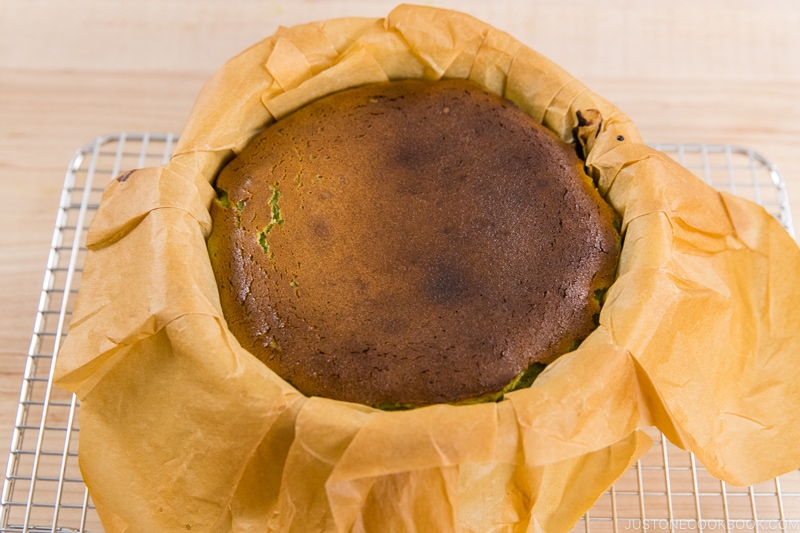
Let the cheesecake rest and set as it sinks down. It will continue to slowly bake and solidify with residual heat. Refrigerate only after the cake is at room temperature so that the hot/warm cake will not spoil other foods in the fridge.
Serve it at room temperature for a softer, custardy filling, or take out the cheesecake from the fridge for 30 minutes before serving, or serve it cold for a firm filling. When you cut, warm your knife with hot water. I fill a tall mug cup with boiling water and dunk the knife before each slice. Bring a towel or paper towel to quickly wipe the knife. Cut in one slice motion and pull out the knife so each slice of the cake has a clean cut.
If your cake is chilled/cold, may I suggest warming it up a little in the microwave? We thought it brings out the flavor of the cream cheese and it’s actually very delicious!
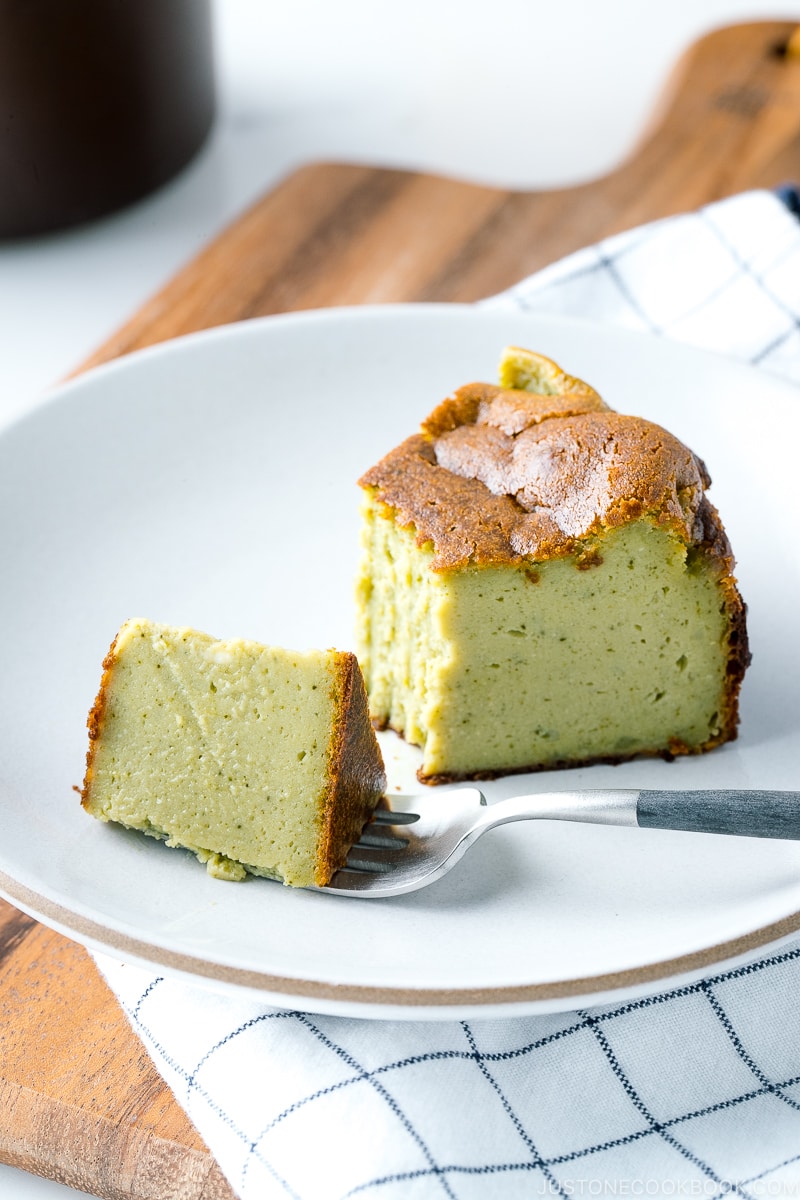
FAQs
I can’t get the top to burn nicely. What can I do?
I can relate, and I really struggled with my oven too. What helped me are:
- Use the convection oven.
- Preheat at a higher temperature. I’ve tried preheating my oven to the hottest 550ºF (290ºC) for a long time, and it seemed to help.
- Bake at a higher temperature.
- Bake at a higher rack as heat rises so the upper oven is supposed to be hotter. However, if your oven is top heating, make sure the parchment paper is not touching the heating element/ceiling.
Can I use a bigger cake pan size?
I mentioned earlier in the post but you can multiply the recipe by 2 to accommodate for a 3-inch deep 7-inch round pan, or multiply the recipe by 2.5 to accommodate for a 3-inch deep 8-inch round pan. You will need to increase the baking time, but since I’ve never tried it, I am not sure how long you will need to bake. As I mentioned in the post, I still recommend this 6-inch cake and bake two cake pans if you want to increase the serving size. It will take slightly longer to bake as you have multiple cake pans in the oven.
My cake cracks on top. What can I do?
When I made my cake batter with a stand mixer or a hand-held whisk, the cake batter seemed to rise higher, sometimes unevenly, and then collapsed, which created cracks. It seemed inevitable as more air bubbles were trapped inside. I’ve tried tapping the cake pan, popping the air bubbles, and resting the batter before baking, which seemed to help a little. But don’t worry too much about the cracks as when the cheesecake is settled, cracks on the burnt top are not so visible like other cheesecakes.
Since I switched to using only the spatula, I had no issue with cracking at all. When I am mixing/blending the ingredients, I don’t see many air bubbles too, so you may want to try using a spatula if these cracks bother you.
How can I achieve a smooth, shiny surface? Mine looks bubbly.
I baked a few cheesecakes with tiny bubbles on the surface before. I’m sure the batter in your cake pan had tiny bubbles before baking it too, or they rose while baking. Follow the same method I shared in the previous Q&A.
Why my cheesecake has a gooey, raw texture in the middle?
I assume you get the gooey texture even after you chill the cake. Then you have to bake the cake for a little longer next time. My oven doesn’t work the same way as yours, and I can only provide suggested baking time or baking temperature using my own oven.
Oh, one last tip: have fun! Important when comes to baking. This Matcha Basque Cheesecake is going to win your heart on its way to your tummy.
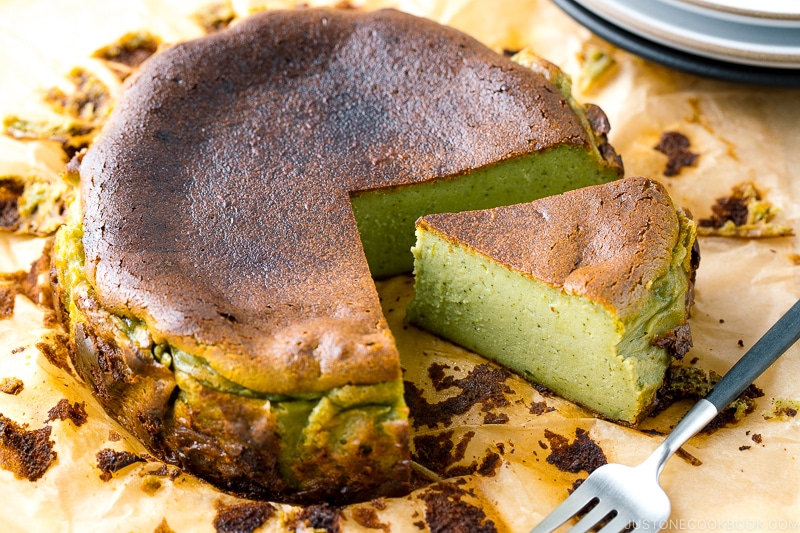
Wish to learn more about Japanese cooking? Sign up for our free newsletter to receive cooking tips & recipe updates! And stay in touch with me on Facebook, Pinterest, YouTube, and Instagram.
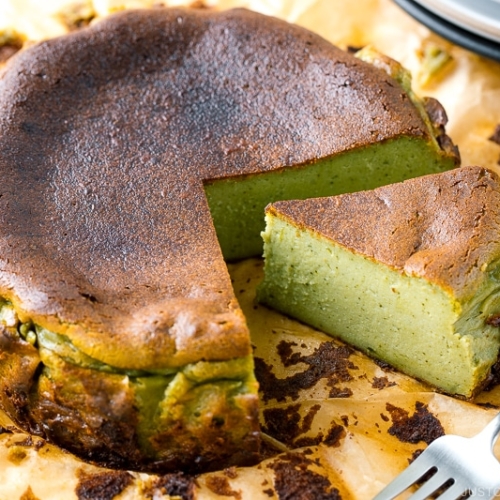
Matcha Basque Burnt Cheesecake
Ingredients
- ½ lb cream cheese (1 block; I used Philadelphia brand; at room temperature)
- ½ cup sugar
- 2 large eggs (50 g each w/o shell) (at room temperature)
- 1 large egg yolk (at room temperature)
- 1 Tbsp matcha (to make a classic version without matcha, substitute with 1 Tbsp lemon juice instead)
- 4 tsp cake flour (or use all-purpose flour; use rice flour for gluten-free)
- 2 tsp cornstarch (or use all-purpose flour)
- 220 ml heavy (whipping) cream (1 cup minus 4 tsp; at room temperature)
- ⅛ tsp Diamond Crystal kosher salt
Instructions
Before You Start…
- Please note that this cake requires 2–3 hours of cooling time. You can serve it either at room temperature or chilled in the refrigerator for an additional 4 hours.
- Gather all the ingredients.

To Preheat the Oven
- Preheat a convection oven (with fan) to 450ºF (230ºC). If you don’t have an oven with a fan, preheat a conventional oven to 475ºF (245ºC). If your oven doesn’t heat up very well, you can preheat it for 30–60 minutes to the hottest oven temperature—mine is 550ºF (290ºC)—then turn it down to the target temperature. As for the oven rack, I used the middle position in my convection oven (the fan circulates the air, so the middle rack is ideal). If you use a conventional oven, move the rack slightly higher as heat rises and the temperature toward the top of the oven is higher. However, keep in mind that a 3-inch deep cake pan needs extra space for rising.
To Prepare the Cake Pan
- For 1 6-inch (15-cm) round cake pan, prepare 2 rectangular sheets of parchment paper long enough to hang over the sides by 2 inches (5 cm). Place them crisscross to maximize the coverage on all sides. (You can use just one sheet instead of two if your parchment paper is extra wide.) Fold them twice into quarters, like a paper napkin.

- Open the folded sheets and place them crisscross as before. Find the center point of the crisscrossed sheets. Where the creases intersect will also indicate the center of the cake pan. Center the parchment sheets over the cake pan ring, then center the removable bottom on top of the sheets.

- Press down the removable bottom and the parchment sheets into the cake pan, creasing the paper against the bottom and inside of the pan to fit snugly. Press and crease the paper edges down around the outside of the cake pan, too.

- Gently take out both the removable bottom and the parchment sheets, which are now molded into the shape of the pan. Place the removable bottom back into the cake pan (as it should be). Then, fit the molded parchment paper back into the cake pan on top of the removable bottom. Press the paper down to fit snugly.

To Blend the Cream Cheese Mixture
- Place ½ lb cream cheese in a large bowl. Make sure the cream cheese is at room temperature. If not, microwave the cold cream cheese at half power (50%) for 45 seconds, or microwave it in 15-second increments until it's at room temperature.

- Press down on the cream cheese with a spatula to soften it. Then, add ½ cup sugar.

- Combine the cream cheese with the sugar by rubbing the mixture against the sides of the bowl with the spatula. The cream cheese will become fluffy and smooth as the sugar granules dissolve. Scrape both the bowl and spatula often to ensure that the ingredients are well incorporated and there are no lumps.

- In a separate bowl, whisk 2 large eggs (50 g each w/o shell) and 1 large egg yolk well.

- Slowly and gradually add one-third of the beaten eggs to the cream cheese mixture. Blend completely and thoroughly, making sure the batter is smooth and without lumps before adding more egg.

- Add another one-third of the eggs to the cream cheese mixture, blending completely.

- Add the remaining egg and blend well. Option: To make this cheesecake with a classic flavor instead of a matcha flavor, add the lemon juice now and blend well. Then, skip to the To Finish the Batter section.

To Incorporate the Matcha
- With a ladle, transfer about two scoops of the batter to a clean, medium-sized bowl.

- Now, blend in the matcha. Use a small, fine-mesh sieve to sift 1 Tbsp matcha into the two scoops of batter, a little bit at a time. Stir as you go to blend the powder into the batter completely before adding more. Continue until you‘ve sifted and blended in all the matcha. Tip: Matcha is a fine powder that becomes lumpy if you add it to a large volume of liquid. Therefore, we have to make a paste with the matcha before adding it to the rest of the batter.

- Mix it all together, making sure there are no lumps and that the matcha is well incorporated into the liquid. Now, it is a thick batter.

- Continue to blend until the matcha batter is completely smooth and without lumps. Then, add one more scoop of the main batter and blend well to loosen up the matcha batter further.

- Now transfer the matcha batter back into the main batter.

- Blend the two batters very well until you have a smooth consistency.

To Finish the Batter
- Next, add 4 tsp cake flour and 2 tsp cornstarch to a fine-mesh sieve. Holding the sieve in one hand, sift a little bit of the flour and cornstarch into the cream cheese mixture while you stir with a spatula. Incorporate the ingredients well before adding more. Keep sifting and blending until you‘ve added all the flour mixture. Take your time doing this. You don’t want any lumps.

- Make sure at this stage that there are no lumps. Then, gradually add 220 ml heavy (whipping) cream (1 cup minus 4 tsp) while you stir. Mix until it’s all combined. Add ⅛ tsp Diamond Crystal kosher salt and blend it all together.

- Pour the cake batter into the prepared pan in one go (avoid stop-and-go) so you don't create any air pockets.

- Tap the cake pan on the countertop a few times to eliminate air pockets. With a bamboo skewer or toothpick, pop the air bubbles if there are any. Then, run the skewer through the batter to remove any bubbles.

To Bake
- Since the cheesecake may overflow during baking, place the cake pan on a baking sheet, just in case. Mine never did, but I still use a baking sheet as it helps to transfer the cake pan to and from the oven. Next, transfer the baking sheet with the cake pan to the oven. Bake at 450ºF (230ºC) for a convection oven or 475ºF (245ºC) for a conventional oven. Bake until the top is dark amber/brown and the center is still very jiggly, about 30 minutes; please keep an eye on your cheesecake because every oven is different. The top of my cheesecake starts becoming dark at the 30-minute mark, then gets dark brown within 5 minutes. If you love a “gooey“ or “oozy“ texture, then you may bake for less time than I suggested, but you must chill your cake well to firm it up before serving. NEVER extend the bake time and thus overcook the cake, even if the top hasn‘t turned dark. The filling will curdle and you can‘t fix it. If the top doesn‘t darken within 30–35 minutes, you will probably need to adjust the oven temperature (or oven rack or preheating time) the next time you make it.

To Cool
- Take out the cake when the surface is dark, burnt color. The cake should wobble when you gently shake the pan. Let the cheesecake cool in the pan on a wire rack until it reaches room temperature, about 2–3 hours. Tip: Don’t put it on the countertop directly and make sure the air can circulate under the cake pan. For example, you can place it on top of a burner grate of a gas range, if it‘s is not in use.

To Chill
- You can serve the cake either chilled or at room temperature (which we like, too). For a chilled or firmer cheesecake, cover the cake in the pan with a tea towel (don‘t use plastic, as condensation may drip onto the cake), and place in the refrigerator for 4 hours.
To Serve
- Remove the cheesecake from the cake pan and carefully peel back the parchment paper. If you have chilled the cake, let it stand at room temperature for at least 30 minutes or up to 2 hours before serving.

To Store
- You can store the cheesecake in the refrigerator for up to 3 days.
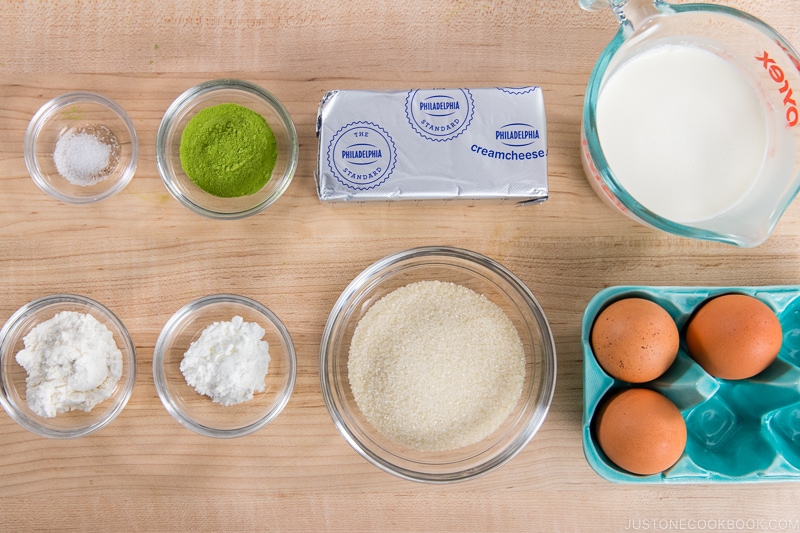
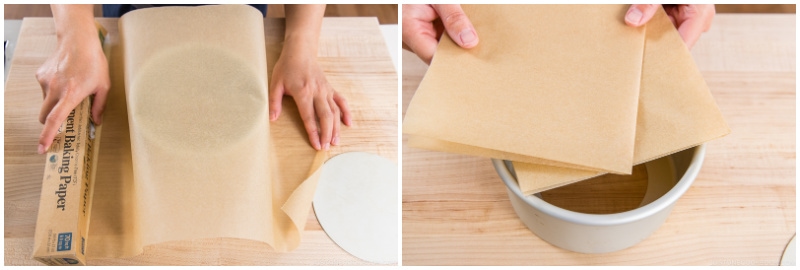
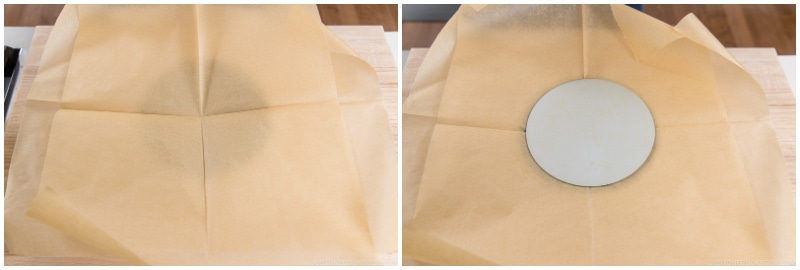
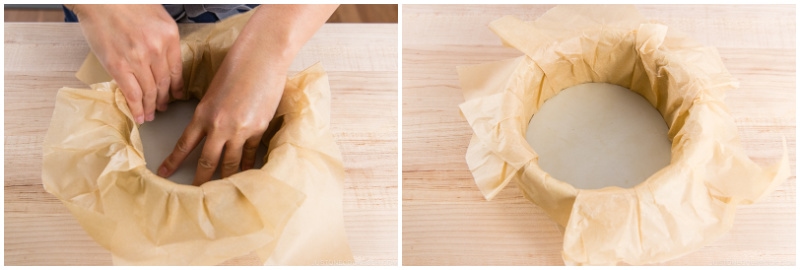
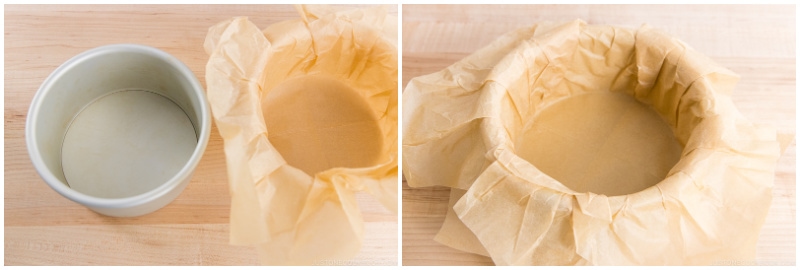
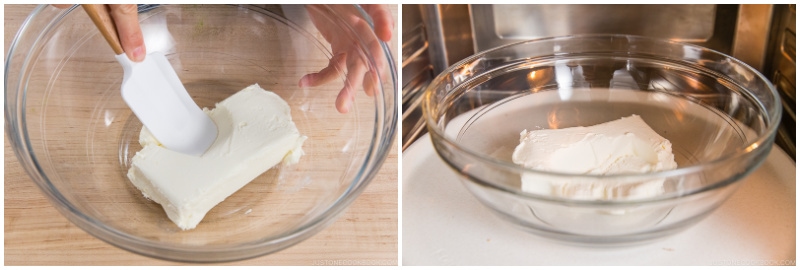
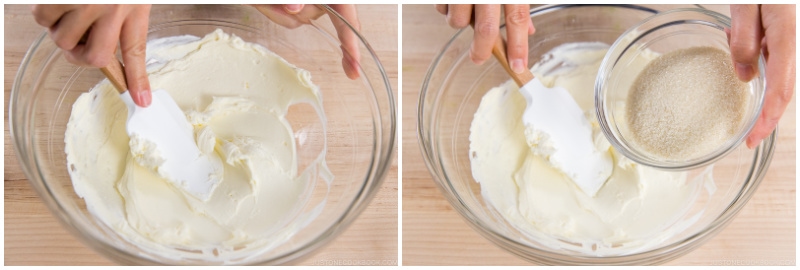
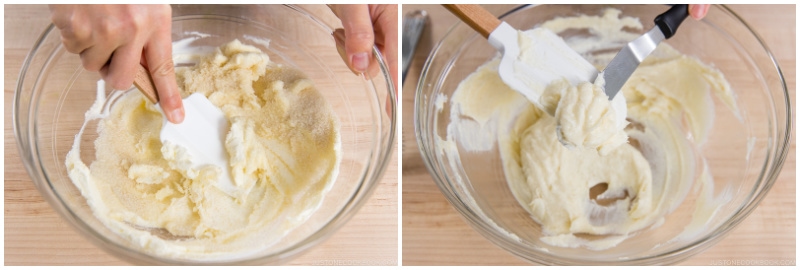
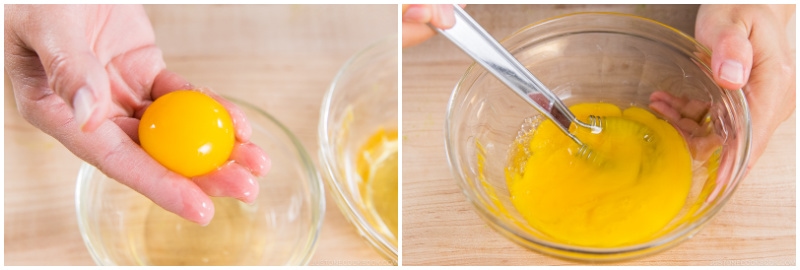
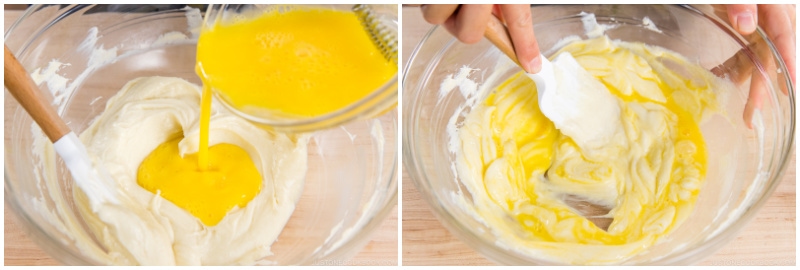
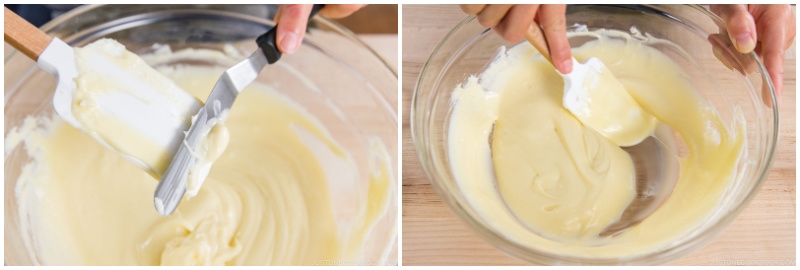
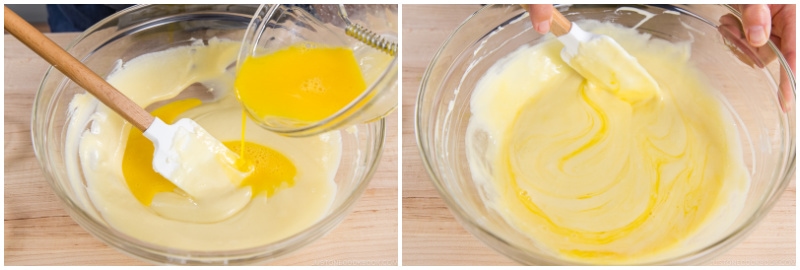
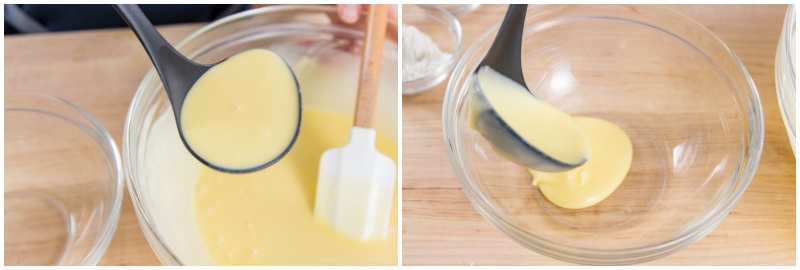
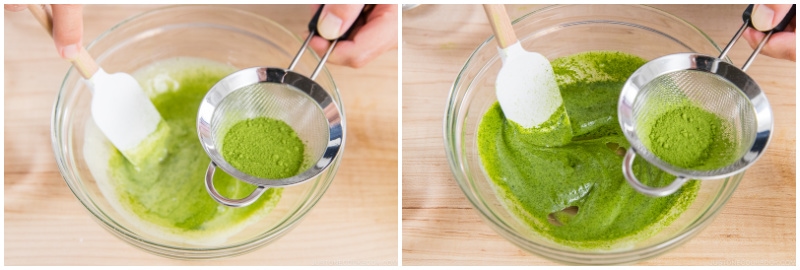
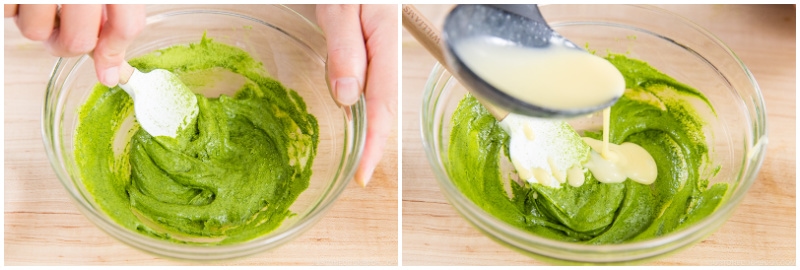
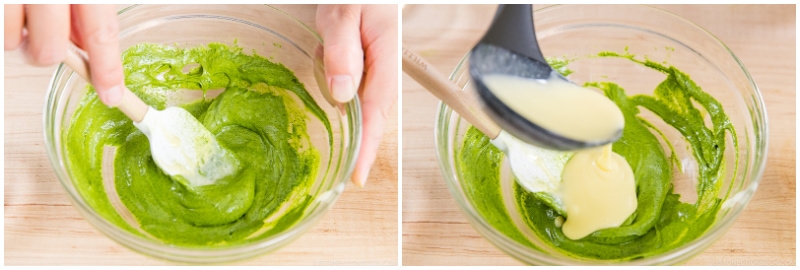
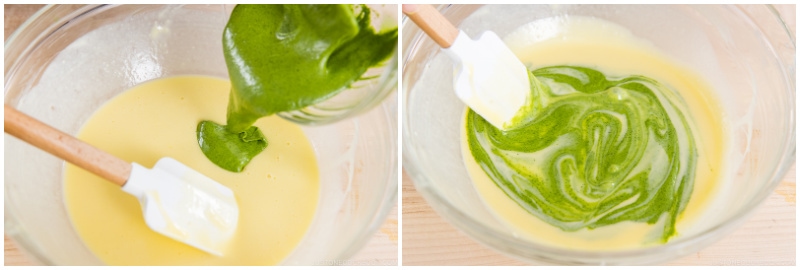
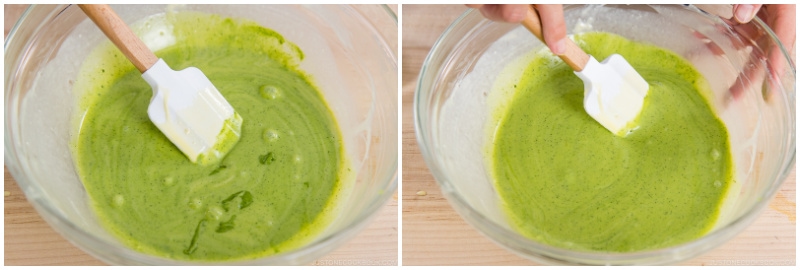
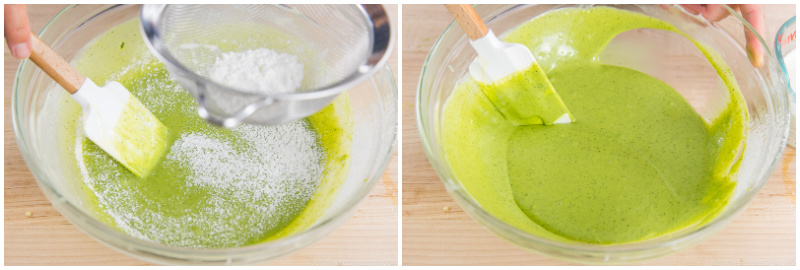
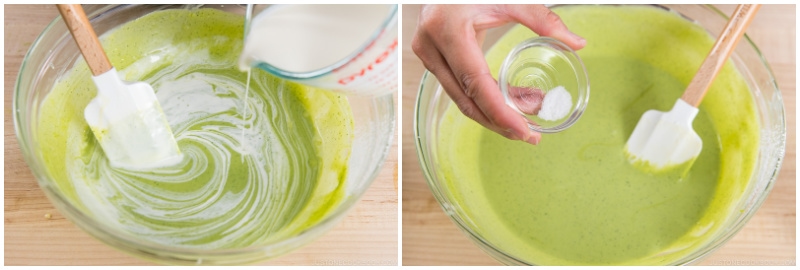
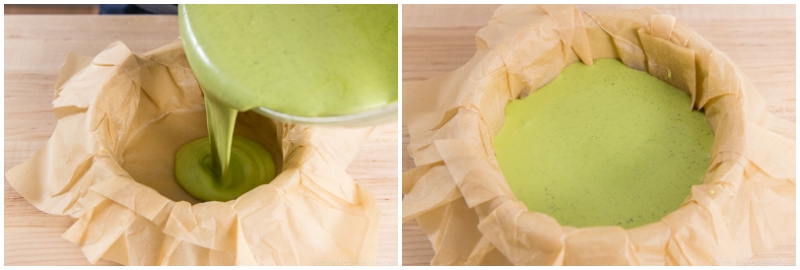
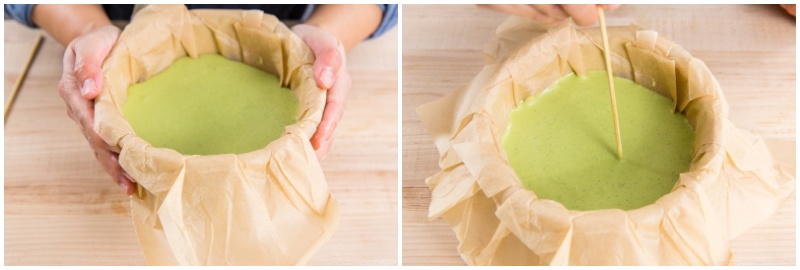
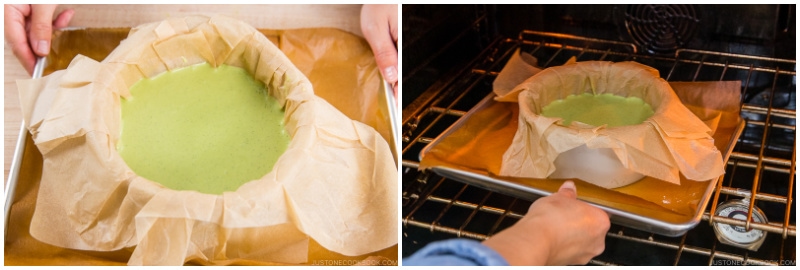
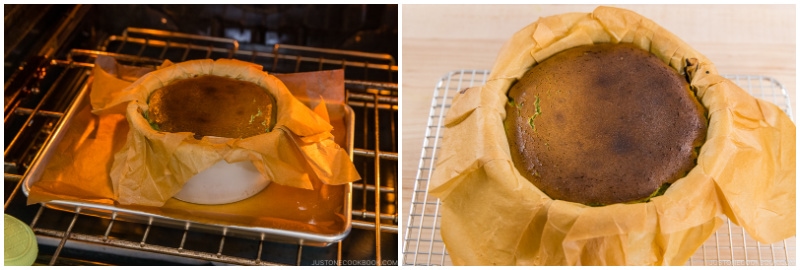
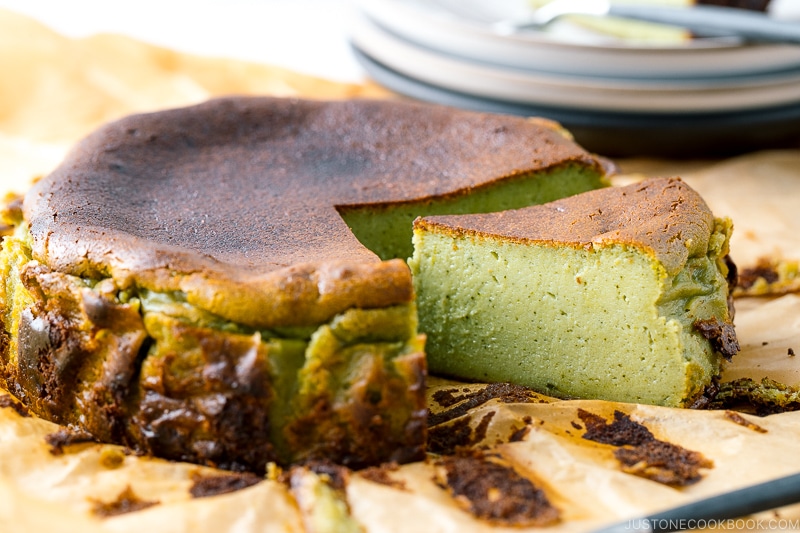










I am wondering why this recipe does not require whipping the heavy cream like https://www.justonecookbook.com/souffle-japanese-cheesecake/?
Is that possible for me to use that method in this recipe?
Hi Joe! Thank you for reading Nami’s post and trying her recipe!
The heavy cream does not need to be whipped for either recipe.😉
We hope this helps!
Made this and it turned out amazing! I was too lazy to use the spatula, but used a stand mixer and basically beat everything in. I also swapped out the matcha and used houjicha instead which was AMAZING. Great recipe, I’m going to use this for all family parties going forward!
Hi Monique! Thank you for trying Nami’s recipe and for your kind feedback!
We are so happy to hear you enjoyed the Matcha Basque cheesecake.
Happy baking! 😊
For the homemade cake flour with cornstarch, can you substitute the cornstarch with potato starch?
Hi Jude! Thank you for reading Nami’s post and trying her recipe!
Yes, you can replace it with potato starch.😉
We hope this helps. Happy Baking!
I love your recipes Namiko! This cake was top notch, so good. I also want to say I really appreciate how precise and detailed your instructions are, I follow them to the letter and it always turns out amazing. Love it!
Hi Lisa! Thank you very much for your kind word to Nami!
Nami and all of us at JOC are so happy to hear you enjoyed her detailed instructions and everything else that we shared. It means so much to us.
We are grateful for your love and support. 💞
Hello Naomi,
Fresh from oven. Do you think it is too pale?
Can’t wait to taste it 3 hours later 🤤
Dee Dee
Hi Dee Dee! Wow! Looks great! 👍
If you prefer the bitter burnt taste, you could bake for one more minute. But we think you did a great job!
We hope you enjoyed the cake! Thank you for trying Nami’s recipe and sharing your cake photo. 🥰
Turn out really 👍🏻 good. Thank you for sharing the recipe❤️
Hi Dee Dee! Awesome! 🤩
Nami and all of us at JOC are so happy to hear you enjoyed the Matcha Basque Cheesecake!
Thank you for trying Nami’s recipe and sharing the photo! 🤗
Great recipes! Tried both matcha and plain. But was wondering why the amount of cream cheese is about half in the matcha version as compared to the plain, while all the other ingredients stay about the same?
Hi David! Thank you for trying Nami’s recipes!
This Matcha Basques Cheesecake is a “Japanese-style” Basque Cheesecake, and it has a lighter, fluffier texture.
If you prefer a more rich flavor and texture, you can increase the amount of cream cheese and Matcha powder.😉
We hope this helps!
Is it possible to make key lime basque cheesecake with this recipe?
Hi Talisa! We hope so, but we haven’t tried yet. Please let us know how it goes!😉
Hi Nami,
I love all your recipes and always got good reviews whenever I bake using your recipes.
I want to bake this matcha cheesecake. May I know why classic Burnt Chesse cake need 2 block of cheese while matcha only use 1 block for a 6 inches?
Thank you..
Zune
Hi Zune, Thank you very much for your kind words. Nami and JOC team are so happy to hear you have been enjoying Nami’s recipes!
This Matcha Basque Cheesecake is a Japanese style which is why Nami used less cheese.😉 This delivers a lighter, fluffier texture, and with the higher egg ratio, the inside is even more custardy and creamy.
If you use more cream cheese, it will be a typical Basque Cheesecake.
We hope this helps!
Just made this for the first time, and it turned out really well! Used an 8-inch silicone pan (because that’s what I had; I lined only the bottom with parchment paper, and you could probably skip that) with the 2.5x recipe increase. Rather than worrying about lumps at each step (except for the matcha mix-in, because no one wants tea clumps!), I strained the final batter and it came out very smooth. I baked it for 40 minutes in a convection oven. At about half an hour I actually smelled burning and found that the top was quite black (hadn’t been keeping an eye on it like I should have!), but I just covered it with foil for the rest of the time and it didn’t end up overdone. I like a firm cheesecake so I let it sit overnight in the fridge; it’s got a consistent texture throughout and I’m quite happy with the results for flavor as well. Much easier than a normal cheesecake, too, both because you get to skip the crust and it takes less time to cook—plus I didn’t have the issue with the top cracking that you get with other cheesecake styles. Will make again, no changes needed!
Hi Erika! WOW! Your Cheesecake looks sooo good!🤩
Thank you very much for trying Nami’s recipe and sharing your baking experience in detail!
We are so happy to hear you enjoyed Matcha Basque Cheesecake!
I’m planning to make this and I only have a regular oven that doesn’t get very hot. So my plan is to preheat at highest temperature (550) for 30-60 minutes as suggested. I will be using the exact size pan as recommended.
My question is, when the preheating is done at 550 degree, should I pop the cake in the oven and reduce the temperature to 475 and bake for 30 minutes (or less if the top gets that burnt color)? Or would that be overcooking the cake?
Thank you and I love your website and make your recipes all the time!!
Excellent recipe! Definitely will make again. I am an avid baker, but this recipe in particular produced a picture perfect outcome and I was so satisfied (as were my guests). Excellent texture, matcha flavor really comes through, especially the day after.
I also decreased the sugar content as others suggested, and strained the batter after every step (a total of about 4 times?) to make sure there were no lumps.
Hi Amelia! Thank you very much for trying Nami’s recipe and sharing your baking experience with us!
We are so happy to hear you enjoyed this recipe!🥰
I get the desire to avoid lumps but you can just strain the batter at the end through the same sifter you used for the dry ingredients. You need to clean it anyways.
For those curious, I used an 8″ wide 3″ deep aluminum cake pan. I also accidentally added an extra 50ml of heavy cream. After settling the cake was probably about an inch high and had the consistency of pudding (or rather, matcha cream cheese?). Taste was good though. Will have to properly multiply ingredients next time.
Hi Adam! Thank you very much for trying Nami’s recipe and sharing your experience with us!
We are glad to hear the taste came out good.🙂
As for a 3-inch deep 8-inch round pan, multiply the recipe by 2.5. It should work better.
We hope this helps!
Hello! If i have a 7″by 2.5″ tin, how much should increase the ingredient amount and baking time by? Would really appreciate some advice on this !!
Hi Val! Thank you very much for trying Nami’s recipe!
You can probably double the recipe, and the baking time should be around 35~40 minutes, but please keep your eye on the last 5 minutes of the baking time and make adjustments.
We hope this helps!
Thanks so much for for this killer recipe!
I have just made one for my mother’s birthday this Boxing Day.
Incidentally I used a 9” x 2.5” silicon pan (all I have at the moment) with double the recipe and baked around 35-40mins.
It seems to have come out beautifully!
I know it doesn’t need decorating, but I was wondering if I could sprinkle some matcha powder through a small stencil saying happy birthday on top? Or will it dissolve away into a mess?
ありがとうございます😊
Hi Damien! Thank you very much for trying Nami’s recipe and for your kind feedback!
We are so happy to hear it came out beautifully!
You can sprinkle matcha powder after it cools off, but you might not be able to see it well. How about writing the letter with Match icing made with Matcha powder, powder sugar, and milk?
We hope this helps!
Just made this! Will taste it tomorrow haha! This time I think I did much better hahaha!😻
Thank you for sharing your recipe 🙏🏻
Hi Juni! Wow! Great job! Looks perfect!!!😍
Thank you very much for trying Nami’s recipe and sharing the photo with us.
Here’s how it looked on the inside. Perfect! All thanks to your recipe! I did cut the sugar to about 70gms tho.
Awesome, Juni! Nami and JOC team are so happy to see the perfect result!
Thank you for sharing your photos!🥰 Happy Baking!